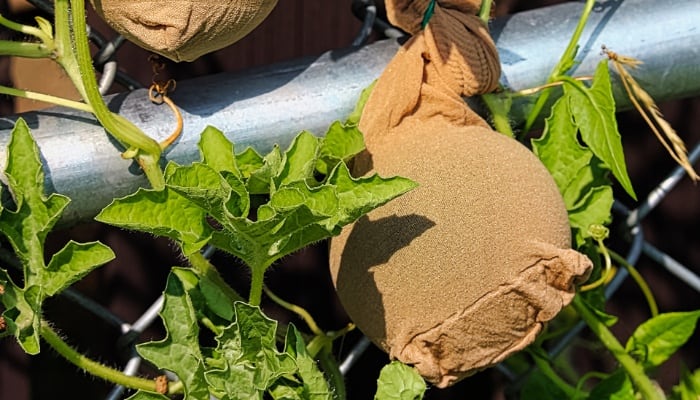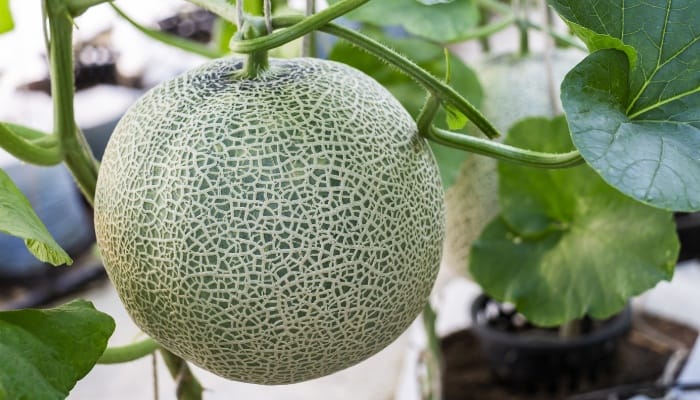It may seem unconventional to grow melons on a trellis, as their weight can be too much for the delicate stems. However, this method is possible and can result in successful growth.
However, when done right, supporting melons on a trellis has many advantages and benefits.
Advantages of Growing Melons Vertically
Growing melons vertically saves space on the ground and allows you to grow other plants around the melon.
Most importantly, it improves the airflow around the melon itself and the vine’s foliage. This prevents fungal and bacterial diseases. It also keeps the fruits out of reach of crawling pests that feed on the melons.
Why Melons Need Support
There’s a reason melon vines tend to crawl on the ground. The fruits are usually too heavy for the vine to support them.
Considering that the melon fruit is attached to the vine by a thin stem, the only thing that can support the fruit is the ground itself.
If you want to grow melons vertically, you’ll need to provide support to the fruits to keep them from snapping off the vine and falling to the ground.
Melon Hammock
A melon hammock or melon sling is one way to provide support for each melon fruit on the vine and prevent the stem from breaking before harvest time.
As the name implies, a melon hammock is similar to a regular hammock. It cradles the developing fruit and provides support in the same way as if it were growing on the ground.
The more time and thought you put into a melon hammock, the more support they provide and the less maintenance work they require later.
Do Melon Hammocks Work?
Melon hammocks are an ingenious idea to protect your melons and save your crops. However, their success depends on the material you use and the quality of the hammocks themselves.
Each fruit growing on the vine should have its own hammock. You also need to make the hammock big enough to accommodate the future growth of the melon.
We’ll cover the techniques and materials to use in great detail below.
Materials To Use
You can use any type of fabric lying around to make a melon hammock. As long as the fabric is breathable and sturdy, it should do the job.
Some of the best materials to use include spandex and jersey fabrics. They have the advantage of stretching, which allows the fruit to grow comfortably.
You could also use any old pair of tights, stockings, or pantyhose. These are all commonly used in various garden applications.
Fishing nets, old netted grocery bags, and fabric masks can also serve as good material for a melon hammock. If you have none of the above, you could always use old T-shirts.

How To Make a Melon Sling
There are a few ways to make a melon sling or hammock.
You could create an actual mini-hammock for each fruit by tying both ends to the trellis, or you could stuff the melon inside the leg tube of the pantyhose and tie the bottom end to prevent the fruit from falling through it before tying the top to the trellis.
The material available will help you decide which method to use. If you have tights, flannel shirts, or other heavy, thick material, then creating an open hammock is the best way to go about supporting the fruits.
First, cut the legs of the tights and use them to create up to six hammocks. Open each piece lengthwise, and then tie both ends to the trellis. The hammock cradles the melon without covering it entirely.
For pantyhoses, netted grocery bags, or fishing nets, you can stuff the melon inside the tube and hang it on the trellis. The breathable and stretching fabric will allow the melon to continue to grow.
When To Give Your Melons Support
You shouldn’t wait for the melons to start growing in size before you consider adding support. It’s recommended to prepare your melon hammocks around the time the fruits are about the size of a tennis ball.
When To Harvest Melons
Most melons ripen in mid-summer. Watch out for cracks in the stems that tell you that the fruits are ripe and ready to harvest.
Common Questions About Growing Melons Vertically
Here are some common questions about growing melons vertically.
Do Melons Do Well on a Trellis?
Growing melons on a trellis is a good way to save space and protect the fruits against pests and wildlife. However, since the fruits are too heavy for the vine to support them, you’ll need to cradle each fruit in a hammock or sling.
What Can I Use as a Trellis for Melons?
You can use a garden trellis 8 feet tall to grow melons vertically. If you’re growing more than one melon vine, then a trellis about 20 feet wide should provide support for the vines.
You can also use wire fencing as a trellis. Spacing the vines is important to improve ventilation.
How Many Melons Per Trellis?
Melon vines tend to spread both vertically and horizontally. For a regular trellis 8 feet tall by 20 feet wide, you can only plant two to three melon vines.
Do You Have To Train Melons on a Trellis?
Melon vines seek to crawl on the ground. Climbing up a trellis or wire fence requires training the vines.
Start as early as the first vines appear. Tie them to the trellis with twine to prevent them from falling back to the ground. You’ll need to do this twice a week until the vines hold onto the trellis by themselves.
How Tall Should a Trellis Be for Melons?
On average, a trellis should be 8 feet tall. You’ll need a ladder to work with melons on a trellis this tall, especially when training, installing the hammocks, and harvesting the fruits.
Closing Thoughts
Growing melons vertically on a trellis saves space and improves airflow in the foliage, but the heavy fruits need to be supported by a melon sling or hammock. You can make a melon hammock from pantyhose, fishing nets, or old shirts.

